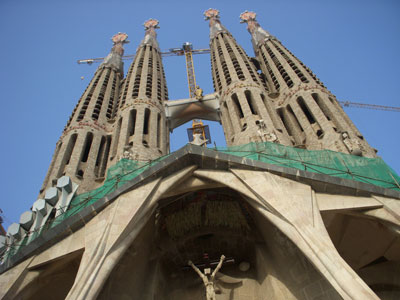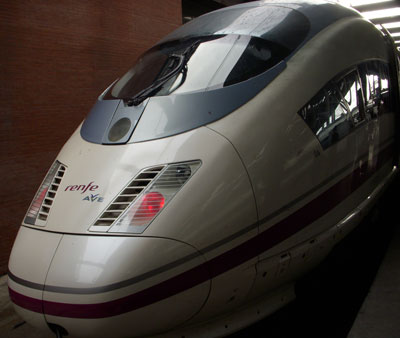New high-speed Barcelona-Madrid
This item appears on page 66 of the July 2009 issue.
by Jay Brunhouse
Minutes after leaving Barcelona Sants Station at 9:30 a.m., where platforms 1 to 6 have been converted from Spanish-gauge to European-gauge, you feel your Siemens Valero E AVE S-103 train begin a smooth transit from 92 mph to 186 mph, according to the speedometer inside the carriage.
The shiny new rails of the eagerly awaited high-speed line connecting Madrid and Barcelona opened on Feb. 20, 2008.
After pausing for clearance at Camp Terragona Station, which opened on Dec. 19, 2006, your AVE leaves the light rain in Barcelona and the greenery gives way to perennially dry, red desert soil, beautiful bluffs and vistas in morning light.
Admittedly, the scenery is not much to write home about, but visions pass kaleidoscopically — tunnels and high cuttings, village churches with crosses atop, a lonely castle atop a lonely hill, isolated villages. . . . No cows but goats and sheep, orange trees, sloping vineyards and silent windmill farms (no electricity today).
About 11 a.m. the scenery turns green. You have arrived in the vicinity of Zaragoza, and your AVE (Alta Velocidad Española, Spanish high-speed) train is one of the few that takes the circular bypass of Zaragoza to avoid stopping at Zaragoza’s 2003 Delicias Station.
Keeping high on the mountainside above the Jalón River, you pass through several tunnels and cross numerous viaducts. Climbing, you reach about 4,000 feet at Alcolea del Pinal, which gives you the distinction of having traveled on the world’s highest high-speed line.
About 12:10 p.m. you join the Seville-Madrid high-speed line and veer northwest into Madrid’s Atocha Station, having covered 390 miles in two hours 38 minutes and averaged 148 miles per hour.
In Atocha, the state-of-the-art High-speed Train Observation Headquarters monitors train positions and progress in all of Spain and coordinates travel for more than 300 train services over nearly 10,000 train miles a day.
Eating and lounging
AVEs carry three classes of passengers. “Club” class is for the VIP passenger. “Preferente” is the equivalent of business class. “Turista” is least expensive. Club-class passengers are served an à la carte menu en route, while Preferente passengers receive a set meal that varies with season and time of departure. The meals are not big but tasty.
Reservations are required for all classes of travel on all Spanish high-speed and overnight trains. Tickets normally include seat reservations, but users of railpasses must make those separately. The Spanish National Railroads (RENFE) closed its downtown Madrid office because Spaniards prefer to book tickets online at www.renfe.es, where tickets cost less than they do at the train stations.
Holding an upper-class ticket or railpass, look for rail clubs (Sala Renfe) on the mezzanine of Madrid’s Puerta de Atocha Station and at Barcelona’s Sants Station (on the center island between elevations to tracks 10 and 11). They are oases of quiet and gentility, featuring overstuffed furniture, magazines, television and Spanish newspapers. You can choose coffee, soft drinks, beer, orange juice and small pastries gratis.
AVE travel between Madrid’s city center and Barcelona’s city center takes about the same time as flying Iberia Airlines (two hours 39 minutes versus one hour 10 minutes of flying time).
The train is more comfortable, has better food and is substantially cheaper in all classes of travel, which explains why RENFE carries over five million more passengers per year than Iberia. Further, passengers on the Madrid-Barcelona line as well as other high-speed services are guaranteed at least a 50% refund if their train is delayed 15 minutes and a full refund if 30 minutes late.
Barcelona
AVE’s new terminus is in the capital of Catalonia, Spain’s second-largest city and principal port. The city is big, beautiful, rich and commercial.
Of all the beckoning attractions of Barcelona, such as the Picasso Museum, the Caixa Forum and the National Art Museum of Catalonia, two venues deserve to attract visitors like a magnet: architect Gaudí’s Sagrada Familia (Church of the Holy Family) and the Palau de la Música Catalana.
In 2008, Sagrada Familia, the Gaudí masterpiece and emblem of the city of Barcelona, celebrated its 125th anniversary. Its four slender spires are to Barcelona as the Eiffel Tower is to Paris.
Gaudí was run over by a tram in 1926. Sagrada Familia, upon which he had started to work in 1884, was completed only through the neo-Gothic crypt and the famous Nativity Façade with its four tall spires that, to some, resemble pretzel sticks studded with salt crystals narrowing at the upper end to points of brilliantly colored rock candy leading to tips of ceramic balls seemingly racked up for a celestial billiard game.
Work was restarted in 1940. The models and drawings that had been preserved allow the work to be continued by computer. Upon its completion in the distant future, it will have 18 towers, the tallest reaching nearly 560 feet.
The Palau de la Música Catalana was not of Gaudí but of a different group of architects at a time when there had been a flowering of the Catalonian spirit in 1905-1908. Paid for by public subscription, it is a landmark of early 20th-century Catalan Art Nouveau or Modernista architecture and designated a UNESCO World Heritage Site.
The Palau first and foremost is the home of musical arts, with 600,000 visitors attending some 400 concerts annually.
Set between the traditional houses of Barcelona’s Old Town, the architectural beauty of the Palau is nearly as admirable outside as it is wondrous inside. The exterior stands out thanks to the magnificent combination of exposed brickwork, stone, glazed ceramics, iron and glass.
The Palau auditorium appears to have leaped out of a magic box. Once inside, you are transported to a rectangular fantasy world where arches, colors, sculptures, columns and leaded-glass windows exude a captivating beauty. The skylight above the auditorium is a spectacular assembly of yellow leaded-glass pieces in the center that gives the impression of a large sun.
Madrid
Spain’s capital city is modern, with a clean and efficient subway and good subway train connections from Europe’s largest airport to the subway hub in the city center.
The cornerstone of Madrid’s “art triangle,” the world-famous Prado Museum, opened a modernist new annex of red brick, granite, oak and marble in fall 2007. The addition allows the world’s richest store of pre-20th-century masters, including Velázquez, Rubens, El Greco and Goya, to breathe.
Extension work begun in 2001 took more than five years and $202 million to complete. The complex added 180,000 square feet to the 312,000-square-foot museum. It, for example, allowed 1,000 additional Goya prints to be displayed and incorporates the cloister of the 15th-century Jerónimo church, which was removed stone by stone and reassembled inside the extension.
It and the other points of the Art Triangle, the Thyssen-Bornemisza and Reina Sofía museums, all are within 10 minutes’ walk of each other along the central Paseo del Prado boulevard.
The Thyssen-Bornemisza Museum, an extensive private art collection, displays works ranging from the 12th century to the present, including masterpieces by painters such as Caravaggio. In its corridors, you can enjoy authentic paintings from important artists like El Greco, Canaletto, Rubens, Zurbarán, Murillo, van Gogh, Gauguin, Picasso, Renoir and more.
The Reina Sofía Art Museum, in an 18th-century hospital, boasts a permanent collection opened in 1992 that offers a complete overview of the main art styles of the 20th century, especially Spanish art, and houses “Guernica,” probably the most well known of Picasso’s works.
Muchas gracias
I thank the Tourist Office of Spain, Chicago, for arranging my transatlantic flight aboard Iberia Airlines from Chicago as well as Preferente AVE travel on Oct. 20, 2008, from Madrid to Barcelona, and return on Oct. 23.
I thank RENFE officials for a briefing and the eye-opening visit to the Madrid Operations & Control Command Center.
Log onto www.spain.info for Spain information.
In Barcelona, I stayed at Hotel Fira Palace (www.fira-palace.com), with rates from €109 (near $143). In Madrid I stayed at the NH Paseo del Prado (www.nh-hotels.com), across from the Prado museum, with rates from €140.


